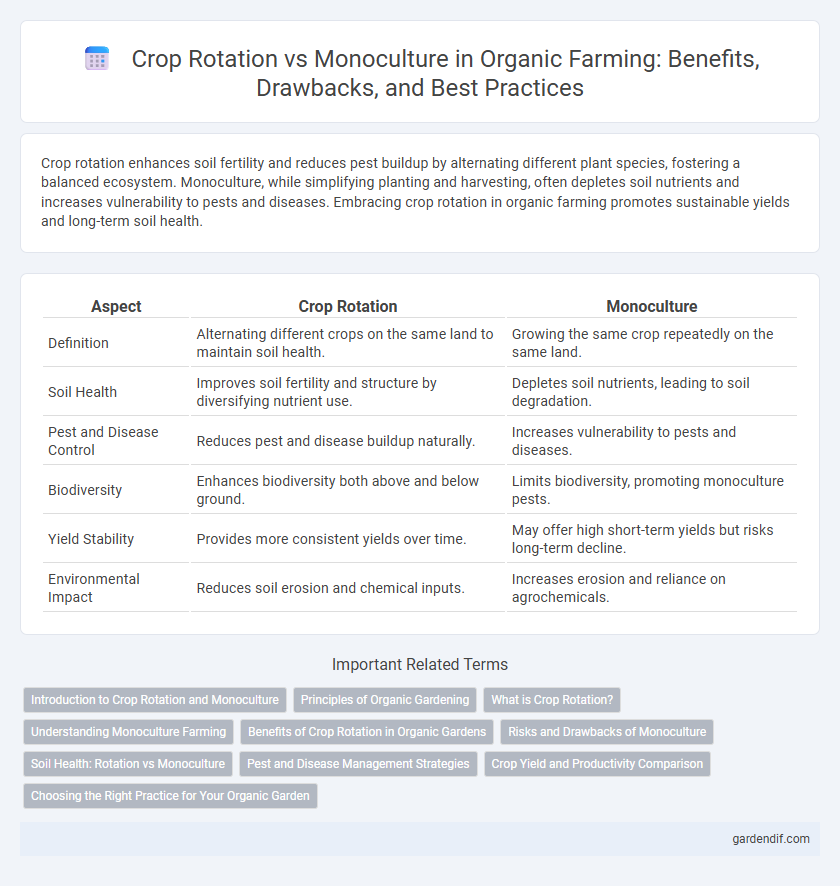
Crop rotation vs monoculture Illustration
Crop rotation enhances soil fertility and reduces pest buildup by alternating different plant species, fostering a balanced ecosystem. Monoculture, while simplifying planting and harvesting, often depletes soil nutrients and increases vulnerability to pests and diseases. Embracing crop rotation in organic farming promotes sustainable yields and long-term soil health.
Table of Comparison
| Aspect | Crop Rotation | Monoculture |
|---|---|---|
| Definition | Alternating different crops on the same land to maintain soil health. | Growing the same crop repeatedly on the same land. |
| Soil Health | Improves soil fertility and structure by diversifying nutrient use. | Depletes soil nutrients, leading to soil degradation. |
| Pest and Disease Control | Reduces pest and disease buildup naturally. | Increases vulnerability to pests and diseases. |
| Biodiversity | Enhances biodiversity both above and below ground. | Limits biodiversity, promoting monoculture pests. |
| Yield Stability | Provides more consistent yields over time. | May offer high short-term yields but risks long-term decline. |
| Environmental Impact | Reduces soil erosion and chemical inputs. | Increases erosion and reliance on agrochemicals. |
Introduction to Crop Rotation and Monoculture
Crop rotation involves alternating different types of crops in the same field across seasons to improve soil health, reduce pest buildup, and enhance nutrient availability, making it a fundamental practice in organic farming. Monoculture refers to cultivating a single crop species continuously, often leading to soil depletion, increased vulnerability to pests, and greater dependence on synthetic inputs. Implementing crop rotation supports biodiversity and sustainable crop production, contrasting with the simplified ecosystem created by monoculture systems.
Principles of Organic Gardening
Crop rotation enhances soil fertility and disrupts pest cycles by alternating plant families, a core principle of organic gardening that promotes biodiversity and ecological balance. Monoculture depletes specific nutrients and increases vulnerability to diseases, undermining long-term soil health essential for organic systems. Implementing diverse crop sequences supports natural nutrient cycling and pest control without synthetic inputs, aligning with sustainable organic practices.
What is Crop Rotation?
Crop rotation is an agricultural practice that involves growing different types of crops sequentially on the same land to enhance soil health and reduce pest and disease buildup. This method improves nutrient cycling by alternating deep-rooted and shallow-rooted plants, preventing soil depletion typical in monoculture systems where a single crop is repeatedly planted. By disrupting pest and weed life cycles, crop rotation promotes sustainable organic farming and increases long-term farm productivity.
Understanding Monoculture Farming
Monoculture farming involves cultivating a single crop species continuously on the same land, which can lead to soil nutrient depletion and increased vulnerability to pests and diseases. This practice often requires higher inputs of synthetic fertilizers and pesticides to maintain yields, impacting long-term soil health and environmental sustainability. Understanding monoculture highlights the importance of crop rotation as a strategy to enhance soil fertility, reduce pest buildup, and promote ecological balance in organic farming systems.
Benefits of Crop Rotation in Organic Gardens
Crop rotation enhances soil health in organic gardens by preventing nutrient depletion and reducing pest and disease cycles commonly observed in monoculture. Varied planting sequences improve soil microbial diversity and structure, increasing organic matter and nutrient availability without synthetic inputs. This sustainable practice promotes higher crop yields and resilience, supporting long-term garden productivity.
Risks and Drawbacks of Monoculture
Monoculture farming significantly increases the risk of soil nutrient depletion and pest infestations due to the continuous cultivation of a single crop species. This practice leads to reduced biodiversity, making crops more vulnerable to diseases and pests, which often necessitates higher pesticide and fertilizer use. The lack of crop diversity in monoculture systems also contributes to soil erosion and long-term fertility loss, undermining sustainable agricultural productivity.
Soil Health: Rotation vs Monoculture
Crop rotation significantly improves soil health by enhancing nutrient cycling, reducing pest and disease build-up, and increasing organic matter content. In contrast, monoculture depletes specific nutrients, fosters pest resistance, and leads to soil degradation and erosion over time. Implementing diverse crop sequences promotes microbial diversity and soil structure, which are critical for sustainable organic farming.
Pest and Disease Management Strategies
Crop rotation improves pest and disease management by disrupting pest life cycles and reducing pathogen buildup in the soil, leading to healthier crops and lower pesticide use. Monoculture increases vulnerability to pests and diseases due to continuous cultivation of the same crop, resulting in higher infestation risks and chemical dependency. Integrating diverse crop species through rotation enhances soil biodiversity and resilience against pests and diseases compared to monocultural systems.
Crop Yield and Productivity Comparison
Crop rotation significantly enhances crop yield and overall productivity by improving soil fertility and reducing pest and disease buildup compared to monoculture systems. Monoculture often leads to nutrient depletion and increased vulnerability to pests, resulting in lower long-term yields. Studies show that rotating crops can increase productivity by up to 25%, promoting sustainable agricultural practices and more resilient food production.
Choosing the Right Practice for Your Organic Garden
Crop rotation enhances soil fertility and reduces pest buildup by alternating plant families, promoting a balanced ecosystem in organic gardens. Monoculture simplifies planting but often depletes soil nutrients and increases vulnerability to diseases, necessitating synthetic inputs that organic systems avoid. Prioritizing crop rotation supports sustainable organic practices, improves yields, and maintains long-term soil health.
Crop rotation vs monoculture Infographic

 gardendif.com
gardendif.com